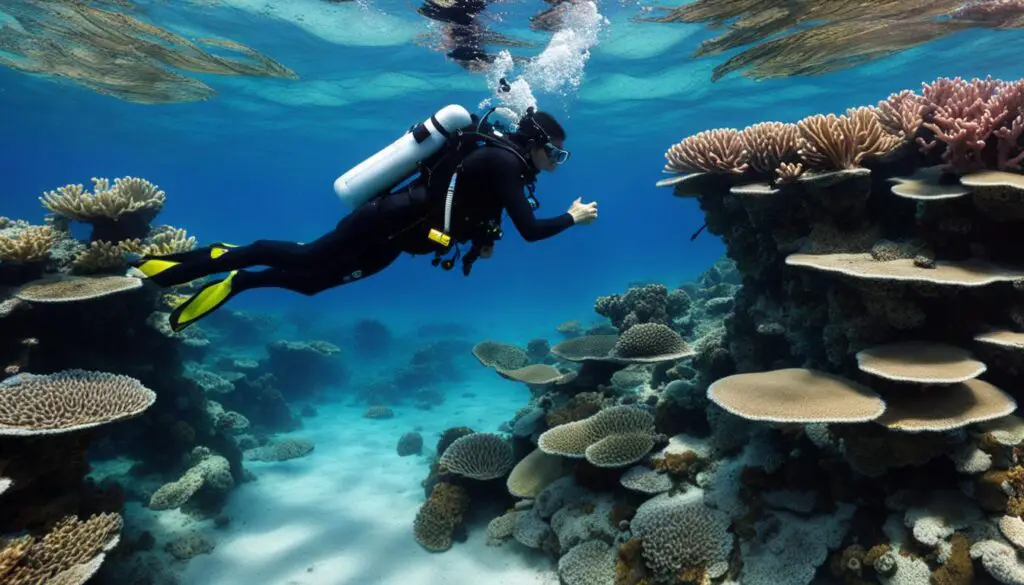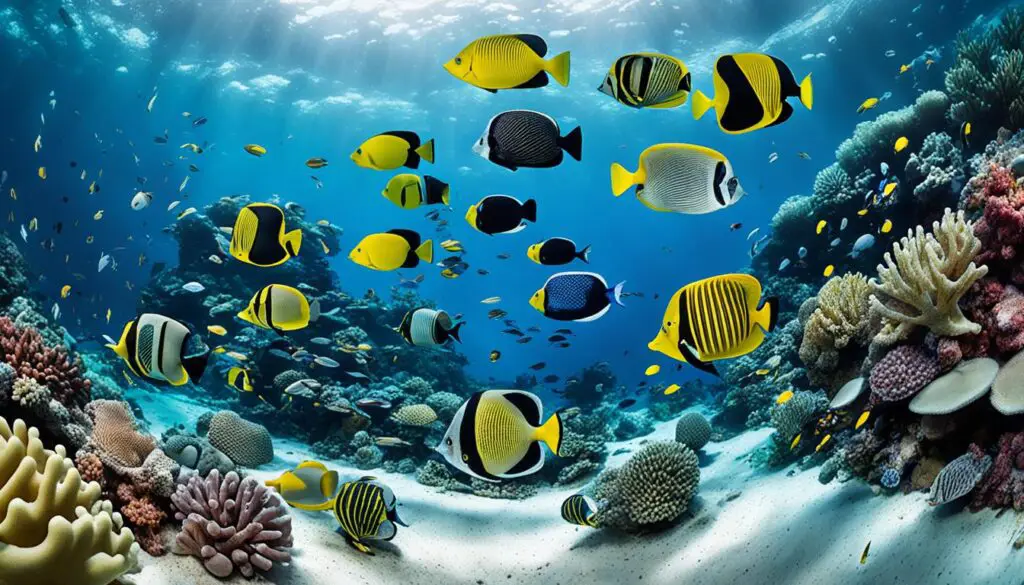Diving is an exhilarating adventure that allows us to explore the wonders of the underwater world. To ensure a safe and secure diving experience, it is important to understand the significance of proper weight distribution while diving. By finding the right balance with the essential weights for diving, we can maintain control over our descent and ascent, achieve neutral buoyancy, and mitigate potential risks.
When it comes to weight distribution in diving, it is all about achieving neutral buoyancy. By adding weights, we can counterbalance the positive buoyancy generated by our diving gear, such as wetsuits and BCDs (buoyancy control devices). The amount of weight required varies based on factors like body composition, equipment, and dive conditions. The right balance is crucial to prevent sinking too quickly or struggling to maintain a consistent depth.
Key Takeaways:
- Proper weight distribution is vital for safe and controlled diving.
- Neutral buoyancy can be achieved by adding weights to offset gear buoyancy.
- There are various types of weights available for diving, including weight belts, weight pouches, and integrated weights.
- Choosing the right type of weight system depends on personal preferences and diving requirements.
- Factors such as body composition, equipment, and dive conditions should be considered when selecting diving weights.
Importance of Proper Weight Distribution in Diving
Proper weight distribution is crucial in diving to achieve neutral buoyancy. The distribution of weights allows divers to control their buoyancy and safely explore the underwater world. By adding weights to offset the positive buoyancy generated by wetsuits, BCDs (buoyancy control devices), and other diving gear, divers can maintain a stable and controlled descent and ascent.
Weight distribution plays a significant role in ensuring safe diving. Too much weight can cause divers to sink too quickly, while too little weight can result in difficulty maintaining a consistent depth. Finding the right balance is essential for a safe and enjoyable diving experience.
To illustrate the importance of weight distribution, consider the scenario of diving without any weights. The lack of additional weight would leave divers vulnerable to the natural buoyancy of their bodies and equipment, making it challenging to control their position and depth. The addition of properly distributed weights enables divers to achieve neutral buoyancy, where they neither sink nor float, allowing for effortless movement and precise navigation underwater.
In the words of renowned diver Jacques Cousteau, “From birth, man carries the weight of gravity on his shoulders. He is bolted to earth. But man has only to sink beneath the surface and he is free.”
Key Factors to Consider for Safe Weight Distribution
- Body Composition: The diver’s body composition, including muscle mass and body fat percentage, affects buoyancy and weight requirements. Factors like varying body types and personal differences influence the distribution of weights needed for neutral buoyancy.
- Dive Equipment: Different diving equipment, such as wetsuits, drysuits, and BCDs, impacts overall buoyancy. Proper weight distribution compensates for the positive buoyancy created by these gears, providing balance and control.
- Dive Conditions: When diving in various conditions, such as freshwater vs. saltwater or calm vs. strong currents, divers may need to adjust weight distribution accordingly. Adapting to different circumstances ensures safety and control during the dive.
As each diving experience is unique, finding the optimal weight distribution requires experimentation and refinement. Divers should consult with experienced professionals for guidance and engage in training sessions to enhance their understanding of safe diving practices.
Finding the right balance in weight distribution is like dancing with the currents. It allows divers to harmonize with the underwater environment, ensuring a safe and unforgettable experience.
| Type of Weight | Description |
|---|---|
| Weight Belts | A belt system worn around the waist, allowing divers to attach individual weights. Offers flexibility in weight placement. |
| Weight Pouches | Pouches that attach to the BCD, providing ease in adding or removing weights during the dive. Allows customization of weight distribution. |
| Integrated Weights | Weights integrated into the BCD, eliminating the need for a separate weight system. Offers streamlined functionality and convenience. |
| Ankle Weights | Weighing systems attached to the ankles, primarily used for specialized diving techniques or equipment configurations. |
| Trim Weights | Weights placed strategically on the diver’s body to maintain proper trim and balance underwater. Enhances stability and control. |
| Harness Weights | Weights attached to the diving harness, useful for technical diving or specific equipment setups that require additional stability. |

Types of Weights for Diving
When it comes to diving, choosing the right weights is essential for optimal buoyancy and control underwater. There are various types of weights available, each catering to different diving needs and preferences.
1. Weight Belts
Weight belts are a popular choice among divers for their simplicity and versatility. They are easily adjustable and distribute the weight evenly around the diver’s waist. This allows for better balance and control during the dive, ensuring a safe and comfortable experience. Weight belts can accommodate diving weights of varying sizes, making them suitable for divers of all levels.
2. Weight Pouches
Weight pouches provide divers with flexibility in weight placement. These pouches attach to the diver’s buoyancy control device (BCD) and can be easily added or removed during the dive. This allows divers to adjust their weight distribution based on specific dive requirements or changing environmental conditions. Weight pouches offer convenience and customization, making them a popular choice for many divers.
3. Integrated Weights
Some BCDs come with integrated weights, eliminating the need for separate weight belts or pouches. These integrated weight systems are built into the BCD, providing a streamlined and hassle-free diving experience. Divers can easily add or remove weights using the BCD’s integrated pockets, ensuring secure weight distribution without the risk of detachment.
Other Weight Options
In addition to weight belts, weight pouches, and integrated weights, there are other weight options available for divers. These include ankle weights, trim weights, and harness weights. Ankle weights can help improve leg positioning and stability underwater, while trim weights enable divers to achieve better balance and trim. Harness weights are often used in technical diving to compensate for the additional gear carried.
Choosing the right type of weight system depends on individual preferences, diving experience, and specific dive requirements. It is essential to assess your needs and consult with a diving professional to determine the most suitable weights for a safe and enjoyable diving experience.

| Weight Type | Features | Pros | Cons |
|---|---|---|---|
| Weight Belts | Adjustable, Even weight distribution | Simple, Versatile | May require readjustment during the dive |
| Weight Pouches | Flexible weight placement, Easy to add/remove | Customizable, Convenient | May shift during the dive |
| Integrated Weights | Built-in to BCD, Secure distribution | Streamlined, Minimalist | Not adjustable during the dive |
| Ankle Weights | Improved leg positioning, Stability | Enhanced control, Better trim | Can cause additional strain on legs |
| Trim Weights | Better balance, Improved trim | Enhanced control, Improved buoyancy | May be challenging to adjust during the dive |
| Harness Weights | Compensation for additional gear | Stability, Better trim | Can add bulk and restrict movement |
Factors to Consider When Selecting Diving Weights
When it comes to choosing diving weights, there are several important factors that should be taken into consideration. One of the key considerations is the diver’s body composition. Factors such as muscle mass and body fat percentage can affect buoyancy and the amount of weight required for a safe and controlled dive. Divers with a higher muscle mass may require more weight to achieve neutral buoyancy, while those with higher body fat percentages may need less weight.
Another factor to consider is the diving equipment being used. Different types of equipment, such as wetsuits or drysuits, have varying levels of buoyancy and can impact the amount of weight needed. Wetsuits, for example, provide some additional buoyancy and may require more weight to counterbalance it. Drysuits, on the other hand, are less buoyant and may require less weight.
Dive conditions can also play a role in the selection of diving weights. Factors such as water temperature and the presence of currents can affect buoyancy and control during the dive. Colder water temperatures can result in thicker wetsuits, which may require additional weight to achieve the desired buoyancy. Similarly, strong currents may necessitate the use of more weight to maintain control and prevent drifting.
To ensure a safe and secure diving experience, it is highly recommended to consult with a diving professional or instructor when selecting diving weights. They have the expertise to assess individual needs and provide guidance on choosing the appropriate weights. Their knowledge and experience can help divers make informed decisions based on their body composition, equipment, and dive conditions, ultimately enhancing the overall diving experience.
FAQ
What is the importance of proper weight distribution in diving?
Proper weight distribution is crucial in diving to achieve neutral buoyancy, control descent and ascent, and ensure a safe diving experience.
What are the types of weights available for diving?
There are various types of weights for diving, including weight belts, weight pouches, integrated weights, ankle weights, trim weights, and harness weights.
What factors should be considered when selecting diving weights?
Factors to consider when selecting diving weights include body composition, diving equipment used, and dive conditions such as water temperature and currents.
